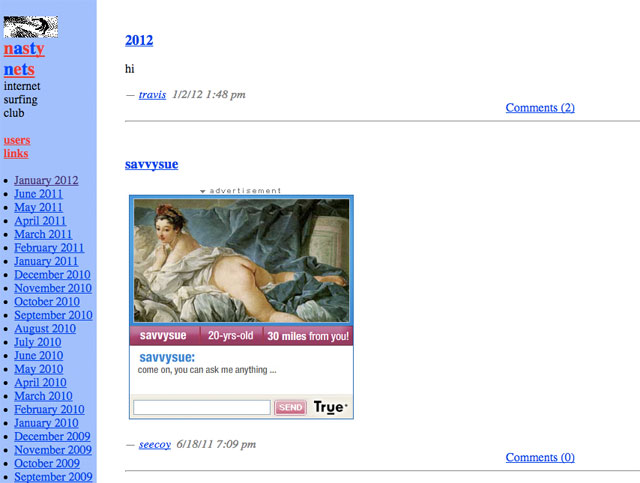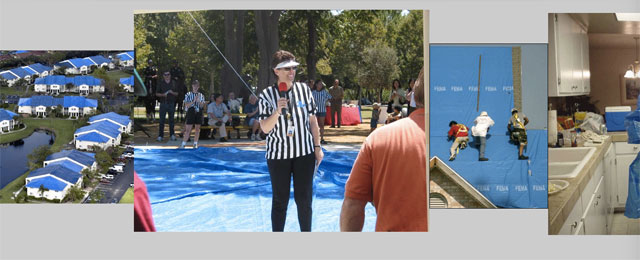
Rhizome’s Professional Surfer landing page
In 2006, Rhizome’s “Professional Surfer” felt like an important show. Surfing informed the practice of most artists I knew, and seemingly countless artist run blogs existed for the sole purpose of collecting weird shit. This included material like an animated GIF of a flag made in ASCII, MS Paint software instructions, and the largest camera lens you’ve ever seen. It was fun to watch and those with a knack for finding the obscure and truly bizarre were followed religiously.
The online exhibition describes itself as a show that “considers web browsing, aka ‘surfing’ as an art form.” Practically speaking, that meant presenting six websites by artists including Olia Lialina’s Pages in the Middle of Nowhere, Travis Hallenbeck’s Cosmic Disciple, Joel Holmberg’s Chillshesh, John Michael Boling’s 53o‘s, and the group blogs Supercentral and Nasty Nets. Each present, combine or recontextualize found material from the web.
Nearly ten years later, we’re still remixing, blogging and collaging material, only we’ve moved to different platforms. Given the relevance of “Professional Surfer” to today’s online culture the question I asked revisiting this show was simple: Does it hold up as an exhibition and a historical document?
The short answer is “no”. It’s an important document, but a bit of a mess. The show’s most obvious weakness is curator Lauren Cornell’s unwillingness to catalogue or interpret the activity on these websites. Take Supercentral, a collective blog founded by Charles Broskoski for friends interested in skateboarding, that included as many as 17 members, (none of whom have posted since 2008). The problem with this site isn’t so much that it’s defunct (who could predict that anyway), but that had Cornell attempted to interpret the activity on the site, she might have discovered it wasn’t a strong inclusion. Paging through the archives is a bit like skimming through someone’s old chats—I often got a “guess you had to be there” feeling. Posts included shots of members beside famous works at MoMA, a Blingee tiger GIF, and seemingly countless altered movie posters—none of which seemed to amount to much. What got posted felt very random.
That cast some doubt as to whether all 17 contributors considered what they were doing “art,” as the show’s press release suggests. Artistic intent tends to be more directed then a bunch of people’s varied interests. The show, though, doesn’t attempt to distinguish between what was professional fucking-around verses a finished art works and the artists often weren’t providing those labels either. Presenting not just what they were doing but why would have been helpful.

Nasty Nets screengrab
To be fair, I get the sense that Cornell was making some distinctions on her own, as roughly half the artists in the show presented art works that drew on material found online, and half were dumping grounds for that material. As examples of the latter, the invite-only surf blog Nasty Nets and Travis Hallenbeck’s livejournal Cosmic Disciple proved much stronger choices than Super Central because their identity and purpose for posting was clear. Nasty Nets, for instance, didn’t exclusively post Internet Ugly material, but it was clearly an interest. This grid of 126 disgusting looking babies provides a pretty great sample of yucky found material on the blog, but I love that the art world’s terrible Dan Colen bird shit paintings also got an inclusion. The Jogging, a popular group blog formed shortly after Nasty Nets (and now also defunct) clearly took cues from this sensibility.
Meanwhile, Hallenbeck’s livejournal—a collection of links to niche music/computer sites, personal lists, and quizes—proved satisfying to click through as well. (My favorite Hallenback find was a quiz that identifies your chemical type and offered an accompanying poem. Hallenbeck got “pheromone”.) None of this seems so dissimilar to Facebook updates now, so it’s hard to explain his importance past perhaps being a valued member of the nerdocracy. While this demographic no longer rules the web, it’s hard to understate the appeal of a indie-music art nerd in 2006. Hallenbeck did this better than anyone.
Ultimately, though, Hallenbeck, Nasty Nets and Supercentral proved an uneven set of artists/bloggers, mirroring the mixed success of their artmaker colleagues John Michael Boling, Joel Holmberg and Olia Lialina. John Michael Boling’s site 53o’s provides a good cross section of that success and failure, with a site that contains one or two hits and a slew of misses that look like rudimentary studies in coding and collage. “Accidental Blue Screen“, the most obvious work in that vein, applies blue screen technology to images with lots of blue so when a user scrolls over those areas new images appear. Basically, it’s a roll over. “Lord of the Flies,” a video in which we see hundreds of cursors descending upon Google, would make up for this, though, were it not broken. It’s a poignant reminder of the one time omni-presence of search. Much of our activity has migrated to Facebook, but the race for traffic and links that this piece implies remains a constant today. Oddly enough, it feels both historical and timely.

Screenshot of John Michael Boling’s “Accidental Blue Screen” 2006.
It’s a thoughtful piece, but also indicative of the most frustrating aspect of the show: how little of it survived. Of the six projects included, only Olia Lialina’s site remains active. The rest are either infrequently updated, entirely inactive or don’t exist. Chillshesh, the section of Joel Holmberg‘s website included in the show, has been removed and replaced by what appears to be a giant screenshot of work selections from 2013-2014. No clues as to what was on the original site exist. Full archiving of these sites as they existed then would provide a good idea of how they actually functioned and were viewed. Nothing lasts forever, but you can slow the process.
It’s perhaps unsurprising then, that Olia Lialina, the artist who has dedicated her life to archiving the amateur web, also hosts the most link-rot free website. One work allows users to toggle through early web buttons and iconography attached to the google maps navigation tool. (Get ready to see a lot of “back” and “home” buttons.) Another takes web 2.0 iconography offline and presents it as a series of prints—a strange inclusion in otherwise web-only show.

Olia Lialina, Some Universe, 2002
The most compelling work, though, is a universe of stars that a user can scroll endlessly upwards. Overlaid we see ladders, windows, colored vertical strips of light, constellation maps and small animated gifs. It’s beautiful and it would seem precious if there weren’t so many twinkling shiny objects in the midnight sky.
But that’s the illusion this show’s shortcomings pierce through; those stars are precious. A ubiquity of images and activity doesn’t equate to a set of infinitely replaceable images and limitlessly shared experience. We need context and functioning archives to understand and preserve this art making history, because if we don’t have it, it will be lost forever.


Comments on this entry are closed.